Newly Discovered Human Species Raises Major Doubt About Origin of Humans
The world is full of mysteries, from Stonehenge to the Bermuda Triangle, but nothing is as puzzling and intriguing as we are. Human history is full of mysteries that we are still trying to solve. Recently, scientists have made a series of new discoveries, making the story of human origins more complex and fascinating than ever.
In a cave in the Philippines, archaeologists discovered a new species of ancient human, named *Homo luzonensis*. The tiny bones, ranging from leg bones to hand bones and a few teeth, have left researchers scratching their heads because of their unique structure. These teeth are much smaller and simpler than those of other human species, highlighting the differences in evolution.
Also in the Melanesian region, scientists have discovered traces of an unknown ancient human species in the DNA of modern people. DNA analysis has shown that, in addition to Neanderthal and Denisovan DNA, Melanesians carry genes from a previously unidentified species. This opens up the possibility that there are many branches of human evolution that have yet to be discovered.
Another remarkable discovery is a fossilized tooth in Spain, which suggests that Homo sapiens may have arrived in Europe earlier than originally thought. Careful examination of the tooth revealed that it belonged to Homo sapiens, which lived between 45,000 and 66,000 years ago, challenging previous theories about human migration.
Discoveries about Denisovans, another ancient human species, are also filling in the gaps in our evolutionary story. A molar found in Laos has provided further evidence of the Denisovan presence in Southeast Asia, confirming the influence of this species on modern human groups in the region.
These discoveries not only expand our understanding of human origins, but also confirm that evolutionary history is a complex and surprising story. With each bone or DNA unearthed, we get closer to solving the greatest mystery of humanity: who we are and where we came from.

The large skull, discovered in an abandoned well, belonged to a man who lived at least 146,000 years ago. Some scientists have called it a new species, *Homo longi* (Dragon Man), but there is debate about whether it is truly a separate species or related to the Denisovan group.
Another skull, discovered in 1978 in China, is 200,000 years old. It shows a hybrid of *Homo erectus* (Upright Man) and *Homo sapiens*, leading scientists to wonder whether it is an evolutionary link or belongs to *Homo heidelbergensis*.

In 2017, a 13-million-year-old baby monkey skull was found in Kenya. This early primate, related to modern apes, sheds light on the evolution of primates during the Miocene.

A 2016 study found that the tooth size of ancient humans followed an “inhibitory cascade,” meaning the size of one tooth influenced the size of the adjacent tooth. The discovery could help reconstruct missing teeth in fossils.
Denisova Cave in Siberia revealed an ancient human species, the Denisovan, through a finger bone. This species shares DNA with Neanderthals and modern humans, providing new insights into human migration and evolution.

In South Africa, *Homo naledi* was discovered in Rising Star Cave, which, despite its small brain, used fire, buried its dead, and carved symbols into stone. The discovery changed the way we look at the capabilities of prehistoric humans.
New research on the skeleton of a “giant wombat” in Australia suggests that marks on its teeth may have come from rodents rather than humans, challenging previous assumptions about interactions between the species and indigenous people.

DNA analysis suggests that humans and Neanderthals interbred around 47,000 years ago, lasting nearly 7,000 years. Modern humans outside Africa still retain 1–2% Neanderthal DNA.

The skull of the Taung child, an *Australopithecus africanus*, was initially thought to have been killed by a leopard, but new research suggests a large eagle may have been the culprit.
LiDAR technology has revealed Maya structures hidden by the Guatemalan jungle. New detailed maps open up exploration of previously inaccessible areas.
Recent research suggests that humans lived on the Azores more than 700 years before the Portuguese arrived in 1427.

Animal bone spoons, dating back 7,500 years, show that Neolithic humans had an understanding of nutrition, which helped to better care for young children and contributed to community development.








